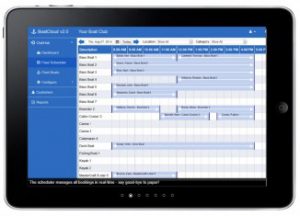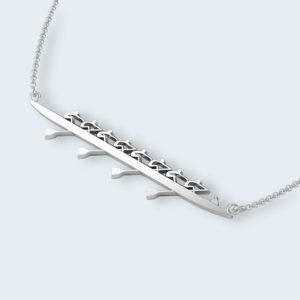I read an interesting article the other day from New Scientist. It was about the work of John Barrow of Cambridge University is doing with boat rigs. It appears that he is fascinated by the various tandem rig options in an 8. I am on the track of the original article and will report on it when I have read it. Meanwhile Justin Millmow’s summary provides some points to ponder and raises more questions than it answers.
There is also a report of the original article on the MIT Technology Review blog and some discussion.
If I understand Barrow correctly he has looked at the turning moments generated by the levers the various athletes have as a result of their differing distances from the pivot point of the boat which is assumed to be the stern. Not surprisingly he comes up with the suggestion that the theoretically most effective rigs are those that have both sides of the crew having equal leverage; so rigs with various variants of the tandem are favoured. Most rowers are aware of the Italian sbbssbbs and the German sbsbbsbs and their mirror images. Barrow has identified two other possible symmetric rigs sbbsbssb and ssbbbbss. He has never seen either of these in use.
He has apparently tried the four in a row option with the help of a crew from Imperial College, though the article doesn’t give any indication of the outing’s success or failure. The German rig is quite common and I have seen the Italian triple tandem pair option occasionally. (NZL W8 World’s 1978). The first of Barrow’s supposedly unseen variations has been spotted in New Zealand. Christ’s College have a very successful rowing programme and have a habit of rigging variations. Peter O’Connor of the Christ’s coaching staff tells me they have used all of the first three of the possible variants and their mirror images. He also told me he wanted to try the ssbbbbss option but was told he mustn’t because it would break the boat.
Millmow discusses reasons for and against such rigging variants and quotes Volker Nolte, the well known biomechanist and rowing coach. The problems associated with complex rigs are given as being associated with the stroke having to row in disturbed water and the possible effect of wash on the sternward members of a same side grouping. Nolte is reported as explaining the single tandem pair in the successful CAN M8 at Beijing as being used because of weight as it allowed for the lighter crew members to be further towards the bow and thus for the boat to run bow up.
No mention is made of other factors often considered by rowing coaches pondering a seating order. Much thought and experimentation goes into the seating order of a crew; skill, power, weight and personality are all factors. Tandem seating orders are often used as a last resort to allow the placement of a less skilled or clumsy athlete more in the middle of the boat or behind a role model who is easy to follow. Another common reason to alter seating order is power; if the bow rower is pulling the boat around she or he is often moved to 2 seat and the weaker number 2 to the bow.
Consider the asymmetry in a 2-. How do we make a pair go straight? Presumably by having varying power applications from bow and stroke? I seem to remember some work on this by Peggy McBride at the AIS in the 90’s. Is this applicable to the bigger boats?
So – do we rig our eights for theoretical best practice? Do we rig our eights to suit the athletes we have? Or do we rig our boats one way and try and teach the athletes to row to suit the boat and the seat they are in?
Duncan Holland








This Post Has 4 Comments
Hello Duncan
I am coaching a high school girls team. Our Starboards are much stronger than our Ports (and they are not experienced with both side rowing). The boat go sideways with every stroke. I have tandem rigged PSPSSPSP to hopefully give mechanical leverage advantage to P reasoning that they are furthest from the middle. Anecdotally, as I ride the launch behind them it appears to be working, The boat is no longer going sideways, and there is much less wiggle. I do not know if they are faster. We will see how they do in their spring racing season.
Cheers
Joe
Cheers
Joe
Good Morning Joe,
thanks for the comment. I have a couple of questions and comments for you. But first, well done for experimenting and finding a solution. Getting the boat to run straight is certainly essential if you want speed. If you are still getting sideways movement during the power phase of the stroke you could try rigging SPSPSPSP.
When you say that your Ports are stronger than your Starboards what are you comparing, erg scores or water performance? What is important is the force applied to the boat rather than absolute strength. A weaker but technically skilled athlete who is better able to connect and lock on to the water will hold a stronger but less skilled athlete straight. If you look at a pair oar crew a weaker bow seat can hold a stronger stroke seat straight if she is skilled enough. In essence if the weaker athlete gets connected earlier she will keep the boat running true.
Do you have access to small boats for training; fours or, even better, pairs? If you do I can suggest various drills to help. If not, and you are limited to the eight only, I would look at timing at the catch, is starboard as sharp and neat at the catch as port? Are they perhaps all a little late? You could try a drill with four at a time where the rowers only row the first few centimeters of the stroke and focus on a quick, efficient connection. Have the cox hold the rudder straight and still and see if the boat runs true.
Long term the answer may be to swap some of the crew sides though this is not always easy.
Good luck with the spring racing!
Duncan
Thank You Duncan. Great suggestions.
For now our water is too cold and fast for me to risk small boat rowing but I can do it in the summer. It is a very interesting idea to go with starboard stroke rigging (SPSPSPSP). We have our first race this weekend, I will tell you how we do and try it if we do not stay straight.
You are spot on regarding the strength question. The strength differential is on the erg. Overall there is a 17+ second difference S greater than P between the two sides per split, so 51 seconds in our 1500 spring race.
I am now beginning our novices in ambidextrous training and will do so in our summer offseason with out varsity
Technique wise the catches are spotty on both sides. Young high school rowers
Any suggestions on drills is appreciated. My major drill for the rowers is the Australian ‘Rusties’ which they call ‘cut the cakes’. It teaches swing, boat movement, and controlled catches
Thank you for spending your time answering my questions
Joe
Good Morning Joe,
Good point about the water being cold and fast, learning to row a pair is better on still and warm!
Some more ideas about how to get you boat running straight:
Start by videoing the catches, directly behind the blades gives a good view, and work on getting everyone in together, quickly, and at full extension. If you post the video, or mail it to me I am happy to have a look and make suggestions. It is really important that you make this a technical challenge for the rowers rather than a reflection on the weakness of Port side. Challenge the Ports to be clever and technically good and emphasise that when the catches are good the boat goes straight.
You could move some of your stronger Port side rowers towards the bow. Leverage, and thus effect on the run of the boat is greater the further from the stern one is so if you move a relatively strong Port from 3 seat to Bow seat and the weaker one from bow to 3 you will have made the total turning moments closer to equal.
I would make speed and efficiency of the catch the main technical focus for the crew. The exercise I call “slaps” is good for this. Have the crew sit still and get half of them to roll together from the finish to the catch position and, instead of putting the blades in the water as normal slap them down still feathered, repeat. Insist that the slap is hard so that the noise is clear and the athletes can self correct to get the slaps together. With kids I make it a game, ‘Who can make the loudest?’ When they have the drill going well move to normal rowing and try to take the changes with you.
Have fun.
Regards
Duncan